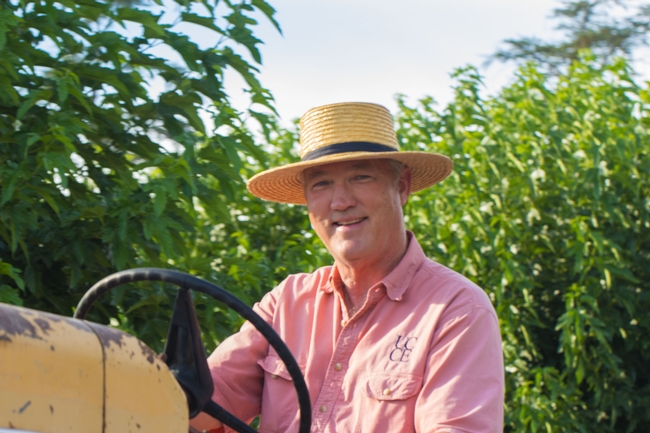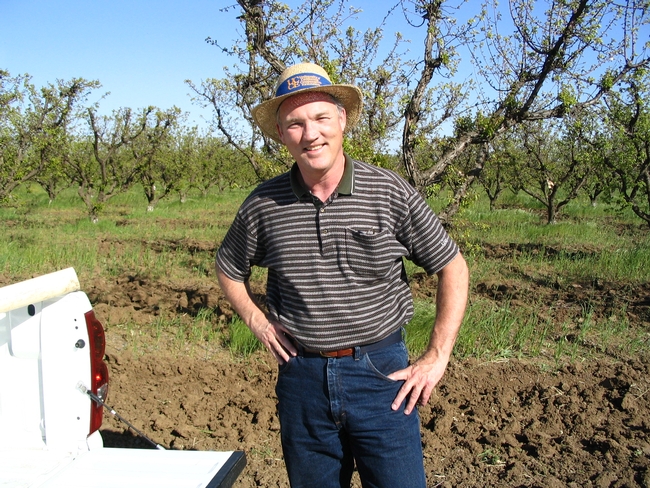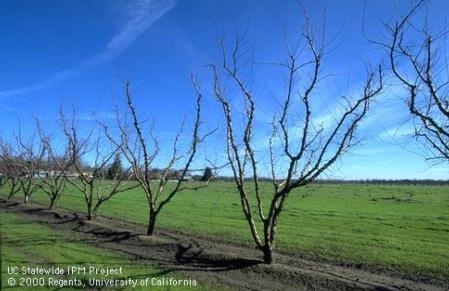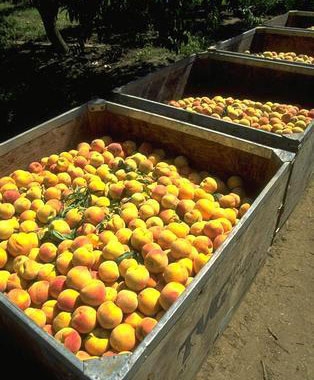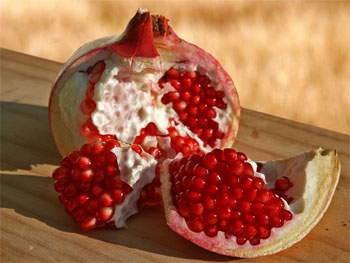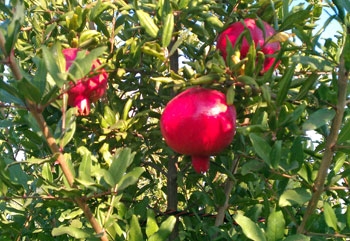Posts Tagged: Maxwell Norton
Maxwell Norton, director of UCCE in Merced County, to retire after 36 years
Maxwell Norton, UC Cooperative Extension director and advisor in Merced and Mariposa counties, plans to retire on July 1. Norton, who specializes in tree fruit, grapes and farmland preservation, has served Merced County growers for UC Agriculture and Natural Resources for 36 years.
Norton is “probably the kind of person everyone would like to know – a kind and gentle soul who exudes knowledge and wisdom,” said Bill Martin, executive director of Central Valley Farmland Trust.
For the past 10 years, Martin has worked on conserving farmland with Norton, who was a founding member of the Merced County Farmland and Open Space Trust, which merged with two other land trusts to become Central Valley Farmland Trust.
“He has an understanding of the landscape that is greatly appreciated,” Martin said of Norton. “He's very low-key, observant and provides timely input on provocative issues that come up at board meetings.”
Raised on a farm near Salida, north of Modesto, Norton studied pomology at Fresno State University, earning a B.S. and an M.S. in plant science before joining UC Cooperative Extension.
During his career, the UC Cooperative Extension advisor has helped Merced County growers solve problems in kiwifruit, Asian pears, prunes, peaches, strawberries, figs and pomegranates.
“When I started in 1979, there was rapid growth of two new industries – kiwifruit and Asian pears,” Norton said. “I conducted some early research trials on kiwifruit and authored a chapter of the new UC Cooperative Extension production manual for kiwifruit. I also spent a lot of time diagnosing Asian pear problems.”
Early in Norton's career, UC scientists introduced a device for measuring soil moisture called a neutron probe. The young advisor tested the device in peach orchards on clay-loam soils, attempting to correlate the probe, gypsum blocks, tensiometers and pressure chamber data.
“All of these tools were relatively new then,” said Norton. “Mid-day values had not been established yet so data collection entailed going out at 3 a.m. to pick leaves and measure the leaf water potential while crouching in the back seat of my government-issued Plymouth Fury.”
Collaborating with his UC Cooperative Extension colleague Roger Duncan in Stanislaus County, Norton conducted several research projects aimed at reducing labor costs in peaches. Projects included mechanical fruit thinning, chemical blossom thinning and various types of mechanical blossom thinning.
Research by Norton and his fellow Cooperative Extension advisors showed that mature prune trees could be pruned every other year and still produce desirable fruit size and maintain yields. Growers widely adopted the practice of alternate year pruning. Later, Cooperative Extension set out to demonstrate the new integrated prune farming practices where IPM tools were integral parts of the system.
In the early 1980s, when many grape growers were spraying pesticides three to four times a year, leafhoppers developed resistance to some insecticides. Norton and other UC experts saw the potential for biological control by the Anagris parasitic wasp. UC Cooperative Extension advisors persuaded growers to not spray the first or second generations of leafhoppers and let the beneficial insects control the pests. Now grape growers rarely have to spray for leafhoppers.
Over Norton's career, agriculture in Merced County has diversified. He began having strawberry meetings translated into Hmong or Lao for immigrant growers and studying pomegranates and figs.
Off the farm, Norton has been active in community development, organizing workshops for farmers on how to export their products, chairing the Merced County Economic Development Task Force twice and serving twice as president of the county's Chamber of Commerce.
“My favorite part of the job has always been doing farm calls, where I went out and visited growers and diagnosed problems, explaining the nature of the problem, and most importantly, suggest things to try,” Norton said.
In retirement, Norton plans on playing his tenor and bari sax in jazz bands, training UC Master Gardeners and volunteering with the local historical society and other organizations.
He has also been granted emeritus status by UC Agriculture and Natural Resources.
RELATED ARTICLE
Capital Press: Advisor helps SJ Valley growers meet challenges, opportunities
Northern San Joaquin Valley is basking in the cold
During the recent cold snap in California, the media turned to UC Cooperative Extension advisors for information on the weather's impact on agricultural production in the Northern San Joaquin Valley.
The consensus for this part of the state: cold weather is good news. The Stockton Record checked in with Joe Grant, UC Cooperative Extension advisor in San Joaquin County.
"We'll take any and all cold that we can at this time of year to fulfill the chilling requirements of the trees," Grant said.
Paul Verdegaal, UCCE advisor in San Joaquin County, a viticulture expert, agreed.
"The good side of the story is we're catching up on the chilling hours, which will produce a good strong bud bread and bloom for all the perennial crops," Verdegaal said. "(Subfreezing temperatures, however,) may be hurting some younger trees and vines, but generally, things are in dormancy, so it's not too much of a problem."
Maxwell Norton, UCCE advisor in Merced County, spoke to the Merced Sun-Star.
"For us out here, the cold nights are good," Norton said. "We fare quite well because we don't grow subtropical crops like citrus and avocados."
Scott Stoddard, UCCE advisor in Merced County, said crop storage facilities need to pay attention to temperature control when the weather gets very cold.
"We have a lot of sweet potatoes in storage," he said. "They guys need to make sure their storage rooms are working properly and don't get too cold."
Roger Duncan, UCCE advisor in Stanislaus County, told the Modesto Bee that warm winters are more harmful than cold snaps such as the one we're experiencing.
"Actually, this is beautiful," Duncan said. "Tree crops need cold in order to break their rest."
Valley farmers are pulling out peaches
Low production, low prices and labor issues are plaguing the California cling peach industry and prompting farmers to pull out their orchards in favor of growing something that carries less risk, reported Joshua Emerson Smith in the Merced Sun-Star.
Many environmental factors can significantly compromise a peach harvest, said Maxwell Norton, UC Cooperative Extension advisor in Merced County.
"For tree fruit you need to have a greater net profit than you do raising tree nuts because growing tree fruit is so much more risky," he said. "The biggest risk of all is not being able to find enough labor during harvest. Peaches, when they're ripe, you have very few days to harvest."
In the Northern San Joaquin Valley, including Merced and Stanislaus counties, about 8.2 percent of bearing acres for clingstone peaches, or 667 acres, have been pulled out of production this fall, the article said.
Because trees are being pulled out, processors are beginning to increase the price they are offering.
Delhi farmer Glenn Arnold said he's clinging to peaches for now.
"I was happy when I heard the price because it's a fair price," he said. "A hail storm can take your whole crop in two minutes. If you don't get compensated adequately for the risk, you might switch to an alternative."
ANR in the news during winter break
While many offices are closed between Christmas and New Year's Day, the media don't stop distributing news. Following is a sampling of recent news stories with an ANR connection.
In battle to save Bonny Doon vineyards, scientists try tricking bacteria
Beth Mole, Santa Cruz Sentinel
But to stop these microscopic killers, scientists had to do some criminal profiling.
When Xylella get into a grape vine, they're released in the vascular tissue -- the plumbing of the plant that pumps water up from the roots. From there, the bacteria use the tissue as "hallways" to invade the whole vine. They then start exploring and munching on the plant.
"We think that the exploratory phase involves rather promiscuous movement of bacteria," Lindow said. But as they spread from place to place, there are only a few bacteria in each area, he said.
Each bacterium constantly sends out a molecular beacon that allows them to collect. Lindow and his team of researchers realized that this beacon is the bacteria's glaring weakness -- without it, they wouldn't make it into their next sharpshooter or kill the vine. So, the researchers engineered transgenic grapevines to make the same beacon.
Pesticide use rises throughout Merced County
Joshua Emerson Smith, Merced Sun-Star
Pesticide use in Merced County is on the rise, according to the annual report from the California Department of Pesticide Regulation. The bump followed a statewide trend that saw an increase in pesticide use after four years of decline.
The reporter talked to Paul Towers, a spokesperson for the Pesticide Action Network, who said, "California is stuck on a pesticide treadmill."
UC Cooperative Extension farm advisor Maxwell Norton said the idea that alternatives to pesticides aren't being pursued is false.
"Pest management has more resources dedicated to it than any other field of agriculture research," he said. "Agricultural researchers are putting a lot of resources into alternative systems. The research reports are there in the hundreds for people to read. We will eventually come up with alternatives."
Leaf curl dilemma
Debbie Arrington, The Sacramento Bee
Folks with backyard peach or nectarine trees face a major problem this winter. Used to control leaf curl, Micro-cop copper fungicide spray and lime sulfur no longer are available to California home gardeners due to environmental concerns. The fungicide sprays that are available have much lower concentrations of copper.
"It's a pretty big deal right now," said Chuck Ingels, Sacramento County UC Cooperative Extension's horticulture advisor. "Those products worked. We don't really have an alternative yet."
This month, Ingels and master gardeners are conducting tests on possible alternatives, such as Liqui-Cop and Concern copper soap, at the Fair Oaks Horticulture Center's orchard. Because the fungus needs water to multiply, they're also testing another approach: Covering whole trees with breathable fabric to prevent moisture from accumulating on the branches.
"Until we know what works, the best option is to plant varieties that are resistant to leaf curl," Ingels said.
Olive oil's secret: Not enough real virgins
Ronald Holden, Crosscut.com
In a report a year ago, UC Davis researchers found that 69 percent of imported "extra virgin" olive oil (and 10 percent of domestic oil) wasn't what it pretended to be. Even the best-known brands showed signs of adulteration —blended with inferior grades of olive oil or cheaper oils from soybeans, hazelnuts, and sunflower seeds.
The lone import to receive top ratings on all points was Costco's Organic Extra Virgin Oil, which sells for one-fifth the price of competing brands.
The colorful, healthful pomegranate is a good food and lovely landscape plant
A jewel-toned garnish for California cuisine, antioxidant-rich elixir of good health, drought-resistant tree ideal for desert-like regions in California, the pomegranate has inner beauty and outward resiliency driving its growing popularity.
Pomegranates have been cultivated since ancient times, and are referred to poetically in texts ranging from the Bible to Shakespeare’s Romeo and Juliet. They are unusual among California fruit. Tough, leathery skin protects bright red, tart-sweet juice sacs, called arils, which are separated in groups by white spongy tissue. Inside each sac is an edible seed which contains fiber and unsaturated fat. The red pulp is a good source of potassium and vitamin C.
More a large shrub than a tree, with multiple trunks reaching a height of 15 to 20 feet, pomegranates are adapted to regions with cool winters and hot summers. Beautiful shiny foliage and a long flowering season make them attractive additions to coastal, inland valley and desert landscapes. Pomegranates tolerate a wide range of soil types, but prefer deep, well-drained loams. The best time to plant is in late winter or early spring – just before they leaf out.
Data about the scope of California commercial pomegranate production is hard to find. USDA stopped collecting pomegranate data in 1989 and CDFA groups pomegranates with kumquats, loquats, persimmons, prickly pears and other unusual fruit. UC Cooperative Extension farm advisor Maxwell Norton said county pesticide registration data indicate that five Central Valley counties – Kern, Fresno, Madera, Kings and Tulare – have about 35,000 acres planted to pomegranate. About 500 acres are planted in other counties combined. Kern County has the highest production with about 17,000 acres producing fruit valued at $115 million per year.
UC Cooperative Extension farm advisor Paul Vossen suggests the following standard varieties for backyard plantings:
- Ambrosia – Huge fruit, pale pink skin, similar to Wonderful
- Eversweet – Very sweet. Red skin, clear juice. Good for coastal areas
- Granada – Deep crimson fruit color. Matures early, but needs heat
- Ruby Red – Matures late, but not as sweet or colorful as Wonderful.
- Wonderful – Large, deep red fruit, large, juice red kernels. Small seeds.
For eating or juicing, select pomegranates at grocery stores by weight, not color. The heavier the pomegranate, the more juice inside. Some consumers are deterred from purchasing and eating the raw fruit because they believe it’s difficult to prepare. UC Master Food Preserver Geri Scalzi gives five simple steps that make eating fresh pomegranate easy:
- Cut off the top half an inch below the crown. Four to six sections of pomegranate arils divided by white membrane will be visible.
- Score the leathery skin with a sharp knife along each section.
- Break the pomegranate apart along the score lines. This can be done under water to prevent squirting pomegranate juice, which tends to stain clothing.
- Loosen arils and membranes and drop them into water. The arils will sink, the membranes will float. Skim off the membranes with a slotted spoon.
- Pour the arils and remaining liquid through a strainer.
The pulpy seed sacs are then ready to be eaten plain, tossed in salads, stirred into yogurt or sprinkled over cereal.
For more information on pomegranate production, attend a public meeting at the UC Kearney Agricultural Research and Extension Center, 9240 S. Riverbend Ave., Parlier, from 10 a.m to 1 p.m. Tuesday, Nov. 29. The following topics will be covered:
- Insect pest update, integrated pest management entomologist Walt Bentley
- Black heart disorder and tree decline issues, UC Davis plant pathologist Themis Michailides
- Interesting selections in the USDA germplasm collection, USDA national clonal germplasm representative Jeff Moersfelder
- Irrigation, fertigation & nitrogen use efficiency with drip irrigation, Claude J. Phené, USDA-ARS
- Summary of acreage trends, Merced County farm advisor Maxwell Norton
RSVP to Yolanda Murillo at ymurillo@ucdavis.edu or (559) 600-7285. The $10 registration fee may be paid at the door with cash or check. More information.

